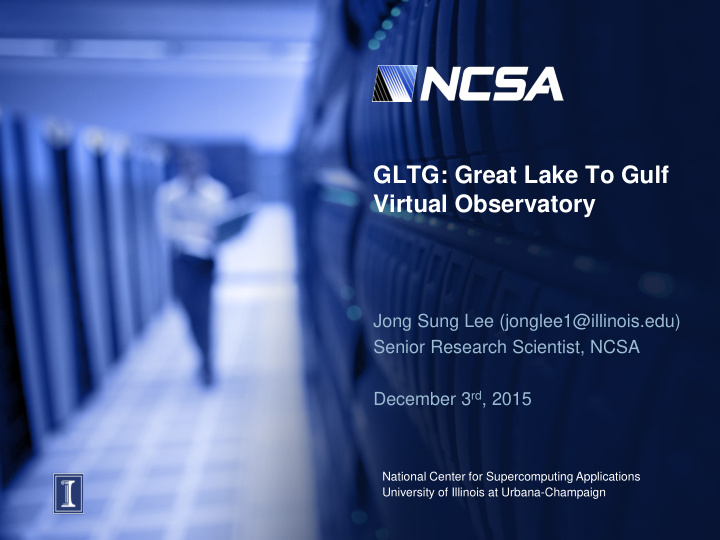



GLTG: Great Lake To Gulf Virtual Observatory Jong Sung Lee (jonglee1@illinois.edu) Senior Research Scientist, NCSA December 3 rd , 2015 National Center for Supercomputing Applications University of Illinois at Urbana-Champaign
The River • Flowing from the Great Lakes to the Gulf of Mexico, the Mississippi River is relied on for its environmental, ecological and economic benefits.
The Watershed • 92% of the nation's agricultural exports are produced in the basin and moved through the river’s 9 foot navigation channel.
The Challenges • Multiple functions, from agriculture to transportation, served by the river combine to help degrade the water quality.
Water Quality Monitoring • Multiple state and federal agencies conduct regular water quality monitoring and data collection. The data is made available to the public through multiple databases and websites.
The Response • Identifying a need to consolidate the available data, the National Great Rivers Research and Education Center partnered with the University of Illinois’ National Center for Supercomputing Applications and Illinois-Indiana Sea Grant to develop the Great Lakes to Gulf Virtual Observatory.
The Mission • To assist our understanding of large river ecology and facilitate decision making through an interactive geospatial application that integrates and visualize relevant data from respected sources.
GLTG Virtual Observatory http://gltg.ncsa.illinois.edu/ • Powered by the NCSA’s GeoDashboard, the Observatory provides access to environmental monitoring data collected throughout the Mississippi River Watershed. • It provides a new resource for stakeholders to inform their research and decisions on how the functions of the river are managed and sustained.
Geodashboard • Platform to provide collect, organize and visualize the sensor data (temporal and spatial) • Built on RESTful web service of GeoAPI and Clowder • Other projects • Great Lake Monitoring https://greatlakesmonitoring.org/ • IML-CZO (Intensively Managed Landscapes Critical Zone Observatory) http://data.imlczo.org/geodashboard/ Imaginations unbound
HOME On the Home page, users have access to all of the Observatory’s available data points. The available data is organized by data source and river reaches and watershed
SEARCH • On the search page users are able to create unique data sets for the specific sites, sources, and parameters that interest them. • Users can then download their selected data sets in common file formats like CSV and JSON.
The Current & Future • After launching with a focus on nutrients and water quality, the Observatory will expand to include additional types of environmental monitoring data in the future.
DEMO • Sensor locations as a static layer
DEMO • USGS SuperStation
DEMO • Comparison
GLTG Virtual Observatory • Production Site (Stable site) • http://gltg.ncsa.Illinois.edu • Development site (new capability but unstable) • http://gltg-dev.ncsa.illinois.edu/
Recommend
More recommend